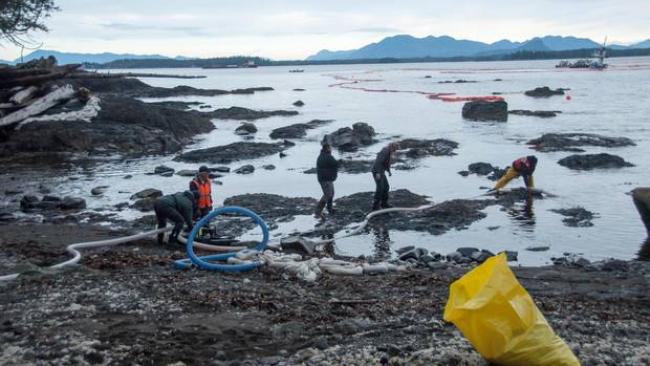Articles Menu

Crews fighting to contain fuel leaking from a sunken tug near Bella Bella, B.C., have had to deal with just the kind of conditions predicted in a spill response analysis filed with the National Energy Board in the Trans Mountain pipeline hearings.
That analysis warned that if an oil spill occurred on the West Coast during winter months, high winds, turbulent seas and delays in response time could combine to make it impossible for crews to recover more than 15 per cent of spilled oil.
However, during the NEB inquiry, which concluded earlier this year, Trans Mountain presented a model that showed over half the oil would be recaptured because of proper planning and the rapid deployment of containment equipment.
The NEB concluded that Trans Mountain’s application “met the requirements … regarding marine emergency preparedness and response planning” and recommended conditional acceptance of the project, which is now before federal cabinet awaiting a decision by December. If approved, the pipeline expansion project will dramatically increase oil tanker traffic through Vancouver harbour from about seven tankers a month to 35.
But the sinking of the tug Nathan E. Stewart near Bella Bella two weeks ago and an accident in Vancouver harbour last year have raised serious questions about oil spill response limitations.
In real life, responders have been slower and less effective than the Trans Mountain model predicted, equipment has broken and drifting oil slicks have been missed.
In April, 2015, the MV Marathassa, a cargo ship at anchor, spilled 2,800 litres of bunker fuel in English Bay. Western Canada Marine Response Corp., an industry-funded organization that responds to spills, later reported recovering 1,400 litres, demonstrating the high recovery rates Trans Mountain had foreseen.
But that was under ideal circumstances. The weather was good and the accident was close to an oil spill response base. Even then, delays in identifying the seriousness and source of the spill resulted in oil contaminating beaches in Stanley Park and led to a public outcry about the slow response.
The Nathan E. Stewart accident, at a remote site on the Central Coast some 300 kilometres from the nearest WCMRC base, has illustrated what can go wrong when conditions are difficult, reinforcing the warnings filed with the NEB by Nuka Research and Planning Group, LLC.
Nuka warned that adverse winter weather could cause containment booms to fail, make it difficult for clean-up vessels to stay on station, make it unsafe for crews and cause oil to sink or wash ashore.
Those are all factors that occurred in the Nathan E. Stewart spill, according to Unified Command Situation Reports. Booms broke, a skiff was swamped and crews were grounded for days by bad weather while an unknown amount of the tug’s 226,840 litres of diesel, and 10,000 litres of heavy oil and dirty bilge water escaped.
After the tug hit the reef, while pushing a massive empty fuel barge, it took oil spill response crews more than 20 hours to get to the scene from the nearest WCMRC base, in Prince Rupert.
The Heiltsuk Nation, which relies on beaches near the accident site for traditional and commercial clam harvests, has called the situation a disaster.
“The damage to the intertidal zone will be massive,” Heiltsuk Tribal Council Chief Marilyn Slett said in a statement. “We’re looking at damage from diesel washed ashore during the spill and now further contamination from broken containment booms leaking diesel on the beach.”
B.C. Premier Christy Clark has called the situation unacceptable, saying B.C. clearly does not yet have a “world class” capacity to respond to a spill. NDP Leader John Horgan has written to Prime Minister Justin Trudeau calling for a better spill response regime, and B.C. Green Party Leader Andrew Weaver has demanded the resignation of provincial Environment Minister Mary Polak.
The Nuka analysis, which was done for the City of Vancouver, the Tsleil-Waututh and Tsawout First Nations, intervenors opposed to Trans Mountain expansion, found there will be many times when conditions are so bad no response is possible.
It states that at Neah Bay, Wash. – which is exposed to the open Pacific much as the reef is that was struck by the Nathan E. Stewart – spill recovery would be possible on only about two days out of seven because of bad weather and rough seas.
The Nathan E. Stewart and Marathassa spills were relatively small, but opponents of increased oil tanker traffic have said the problems posed by those accidents show just how hard it will be to deal with a big spill.
In the Trans Mountain hearings, however, the NEB concluded the proponent had proposed “appropriate measures” to respond to any accident, and that “a large tanker spill is not a likely event” because ships will be double hulled and have tug escort.
[Top photo: The Heiltsuk Nation, which relies on beaches near the tug accident site, has called the situation a disaster.
(April Bencze/Heiltsuk Nation)]